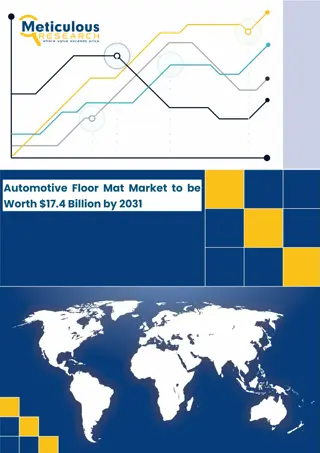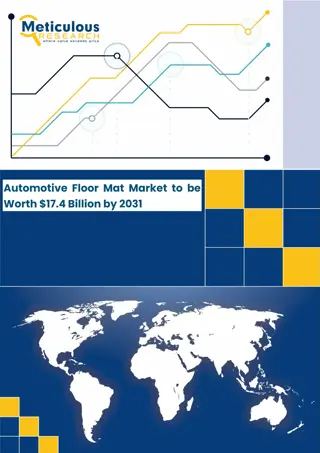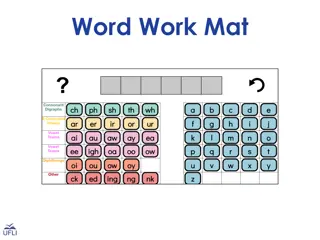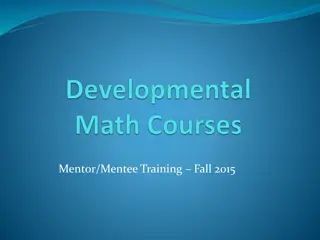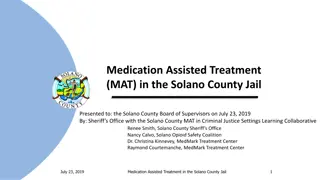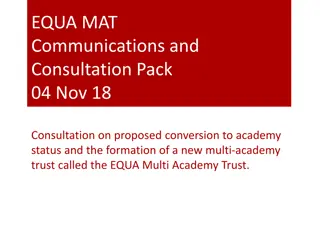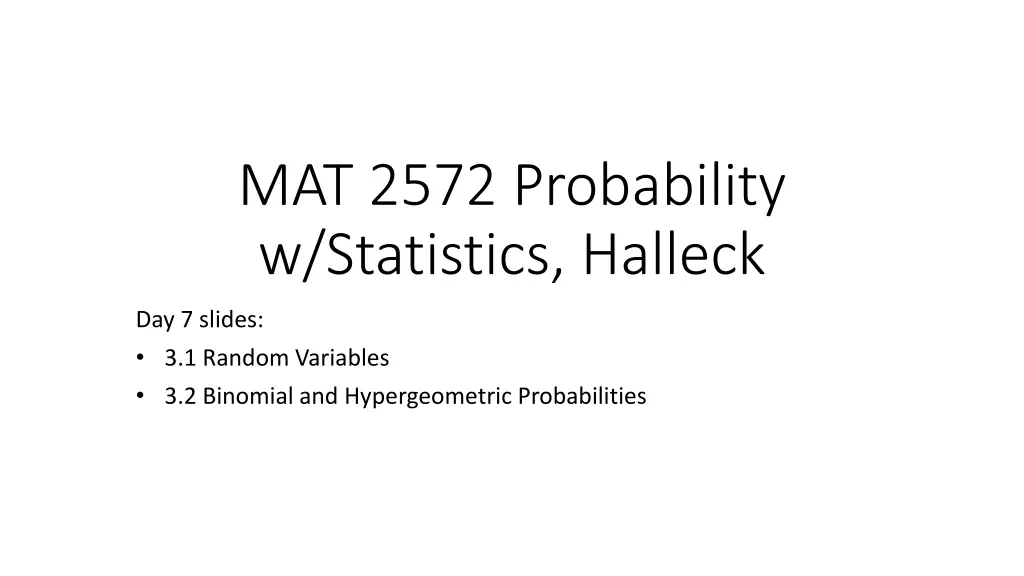
Understanding Random Variables in Probability
Explore the concept of random variables in probability, including examples of discrete and continuous variables with infinite ranges. Learn about Bernoulli experiments, binomial distributions, and how to distinguish between various types of random variables.
Download Presentation

Please find below an Image/Link to download the presentation.
The content on the website is provided AS IS for your information and personal use only. It may not be sold, licensed, or shared on other websites without obtaining consent from the author. If you encounter any issues during the download, it is possible that the publisher has removed the file from their server.
You are allowed to download the files provided on this website for personal or commercial use, subject to the condition that they are used lawfully. All files are the property of their respective owners.
The content on the website is provided AS IS for your information and personal use only. It may not be sold, licensed, or shared on other websites without obtaining consent from the author.
E N D
Presentation Transcript
MAT 2572 Probability w/Statistics, Halleck Day 7 slides: 3.1 Random Variables 3.2 Binomial and Hypergeometric Probabilities
Random variable: first approach Experiment with (real) number outcomes Flipping a coin is NOT: S={h,t} Rolling 2 dice is NOT: S={(1,1),(1,2), (6,6)} However, we get an RV if we flip a coin 5 times and count the number of heads: S={0,1, ,5} Sum the faces of the dice: S={2,3, ,12}
Random variable: second approach A real-valued function that operates on a sample space. Flipping coin 5 times & getting a sequence, e.g., hhtth is experiment; counting number of heads is RV Rolling 2 dice & recording face values as ordered pair is experiment; summing the face values is the RV
Random variable: discrete vs continuous Random variables can either be discrete (as are our coin and dice examples) continuous, e.g., heights of people to infinite precision (not realizable in practice: all measurements are technically discrete as there is rounding, e.g., for heights, typically to the nearest inch or cm) Can you come up with other examples of discrete and continuous RVs? In particular, an example of a discrete RV which has an infinite range?
Example of discrete RV with range Flip a coin until you get a head and record the # flips it takes. It is theoretically possible for the experiment to continue forever. The sample space is 1,2,3, If the chance of getting a head is , then sum of the probabilities is 1/2 1 1/2= 1 the geometric series 1/2+1/4+1/8+ = This is an example of the geometric distribution and shows that the continuous does not have a monopoly on the infinite!
Bernoulli experiment Flip coin n times and record outcome as a sequence of heads and tails. To get an RV, we typically count the number of heads. Equivalently, an experiment with 2 outcomes is repeated n times. Outcome is a sequence of successes and failures . To get RV, we then count the number of successes .
Binomial distribution Given Bernoulli experiment, set chance of heads = p (coin could be bent) and chance of tails = q ( = 1 p). The probability of a particular sequence, is p#headsq#tails e.g., HTHTHHH has chance p5q2. #sequences with k heads and n-k tails is ? so chance of such a sequence is ? E.g., chance of sequence with 5 heads and 2 tails is 7 (why?) ? ?pkqn-k= ? ?pk(1 p)n-k. 5p5q2.
Chance that a 7 game series ends in n games World Series (baseball) 7 game series 1stteam to win 4 games is champion Hence series can last anywhere from 4 to 7 games. Calculate likelihoods that series lasts 4, 5, 6, or 7 games. Assume that (1) each game is an independent event (2) American League team wins any particular game with a p chance
Chance series ends in 4, 5, 6 or 7 games Trick is to think what must happen before the final win: If n=4, then losing team won none of 3 preceding games: p3p +q3q. If n=5, losing team won once in preceding games 4 1p3qp + 4 2p3q2p + 5 3p3q3p + 6 1pq3q 2p2q3q 3p3q3q If n=6, losing team won twice in preceding games: 5 If n=7, losing team won 3x in preceding games: 6
Chance series ends in 4, 5, 6 or 7 games If the American and National league teams are equally likely to win any game, then p = q = and P(4) = p3p + q3q = 1/8. P(5) =4 1pq3q = 1/4 P(6) = 5 2p2q3q = 5/16 P(7) =6 3p3q3q = 5/16 1p3qp + 4 2p3q2p + 5 3p3q3p + 6
Example 3.2.4: the math nerd folly P(SAT math 600) = 0.231, while P(SAT reading 600) = 0.191. The math nerds propose the following game: 4 students A will be selected randomly to provide their math scores; 4 students B will be selected randomly to provide their reading scores If #A>600 exceeds #B>600, then the last class will be spent doing math. Otherwise it will be spent reading. What is the chance that the class will be doing math on the last day?
Example 3.2.4 cont. chance that more get math scores above 600 corresponds to the sum of the entries above the diagonal: 38% Hence there is almost a 2/3 chance that they will be reading on the last day class, certainly not what the math nerds had in mind. R\M 0 1 2 3 4 0 0.149796 0.179989 1 0.141463 0.169977 0.076589 0.015338 0.001152 0.404519 2 0.050098 0.060196 0.027123 0.005432 0.000408 0.143257 3 0.007885 0.009475 0.004269 0.000855 6.42E-05 0.022548 4 0.000465 0.000559 0.000252 5.05E-05 3.79E-06 0.001331 0.349708 0.420195 0.189334 0.037916 0.002847 0.0811 0.016241 0.00122 0.428345 1
Hypergeometric Distribution An urn contains r red chips and w white chips, where r + w = N. Draw n chips from the urn one at a time without replacing any of the chips selected. What is chance that exactly k red chips were among the n removed? (note: if replacement happens each time a chip is removed, this would be a special case of the binomial distribution. What would p equal?) 4 2 6 = 6 20 6 7 6= 10 5 2 10 5 Example: n=5, r=4, w=6 (then N=10). What is P(2)? 21
Example 3.2.6 Fantasy Five Lottery fraud? A player chooses from a card containing the # s 1-36. Each day 5 # s are chosen at random. If the player matches all 5, winnings are up to $200,000 for a $1 bet. There were allegations that certain biases were happening namely that the winning # s were more likely to be chosen from 1 to 12. Let s investigate this allegation. P(3 of winners are among # s 1-12) = In one year, 18% of draws had that makeup. Do we have enough evidence to say that there was bias?
Example 3.2.8 Tax collector misbehavior Tax collector short of funds delays redepositing payments 10x. Money was subsequently deposited in proper account. Tip-off to behavior was delay of redeposits. During period of irregularities, there was a total of 470 tax collections. 19 payments were audited. Auditor reports problem only if she finds 3 or more delays. What is chance that collector will get caught? N=470, n=19, r=10, w= 460 10 0 19 470 19 = 1 0.6592 0.2834 0.0518 = 0.0056 So less than a 1% chance. 460 18 460 10 1 10 2 460 17 P(X 3)=1 P(X 2)=1 + + 470 19 470 19




